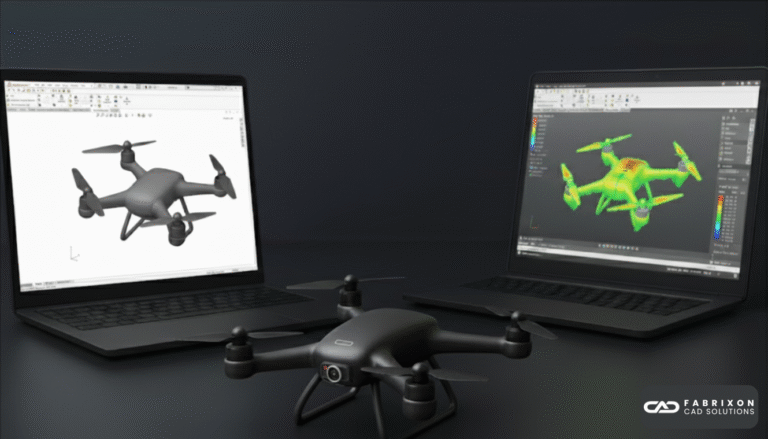Professional Computational Fluid Dynamics (CFD) Services
Optimize your product performance with our practical CFD simulation services. Using SolidWorks Flow Simulation, we offer basic computational fluid dynamics solutions, to help you visualise airflow, fluid flow and heat transfer scenarios for cooling, ventilation, and basic aerodynamics applications.
- Quick, visual flow simulations to guide design decisions
- Basic airflow and thermal assessments to improve product efficiency
- Cost-effective evaluations for early-stage prototyping
- Rapid design variation testing to optimize performance
- Streamlined reports with clear, actionable results
Ready to get started? Share your requirements today. We respond quickly and deliver results that speak volumes!
Get Free Quotation Now
We are committed to understanding your requirements and crafting a tailored solution that aligns with your goals. Enter your details and someone from our team will reach out to find a time to connect with you.
What is Computational Fluid Dynamics?
CFD (Computational Fluid Dynamics) is a numerical technique used to simulate the behavior of fluid flow, heat transfer, and associated phenomena by solving mathematical equations that govern fluid motion. This engineering tool allows us to virtually analyze how liquids and gases move around and through objects, revealing velocity patterns, pressure distributions, and temperature gradients.
We specialize in practical CFD solutions using SolidWorks Flow Simulation for basic to intermediate applications in cooling systems, ventilation design, and aerodynamic assessments.

What do we offer under Computational Fluid Dynamics Services (CFD)?
At Fabrixon, we apply accurate computational methods for fluid dynamics to solve real-world engineering problems. Our team offers practical insights into fluid behavior using SolidWorks Flow Simulation, robust meshing techniques, and validated computational fluid dynamics equations.
We simulate fluid flow within closed domains such as pipes, ducts, and manifolds. These simulations help identify flow uniformity, recirculation zones, and pressure losses. This approach is ideal for HVAC systems, cooling circuits, and process piping applications.
Our external flow simulations assess aerodynamic performance of structures exposed to open air environments. From vehicle drag analysis to valve resistance and electronic enclosure optimization, we use computational fluid dynamics (CFD) to enhance both form and function.
We minimize energy loss and improve system performance by calculating pressure drop through pipes, bends, valves, and fittings. Our simulations account for frictional losses, minor losses, and flow regime characteristics to deliver accurate, actionable results.
We analyze heat transfer characteristics in electronic enclosures, heat sinks, and cooling systems using SolidWorks Flow Simulation. Our CFD analysis evaluates temperature gradients, thermal hotspots, and heat dissipation patterns to optimize cooling performance and prevent overheating in various applications.
Our electronic enclosure cooling simulations help optimize thermal management in PCBs, control panels, and electronic components. We use computational fluid dynamics to analyze cooling circuits, airflow patterns, and heat transfer efficiency to ensure reliable operation and extend component life.
We optimize HVAC systems for improved air distribution and energy efficiency using CFD simulation. Our analysis evaluates airflow patterns, temperature gradients, and pressure distributions to enhance comfort, reduce energy consumption, and ensure proper ventilation throughout building spaces.
Our CFD Simulation Process
Explore our step-by-step CFD simulation process at Fabrixon. Stay connected to track progress in the computational fluid dynamics project.
Benefits of Computational Fluid Dynamics
There are numerous benefits and practical basic applications of computational fluid dynamics. Fabrixon provides high-impact services that reduce prototyping costs and accelerate development timelines.
Early Testing of Performance
Computational Fluid Dynamics enables virtual testing capabilities. We identify design flaws and validate concepts before investing in expensive physical prototypes.
Understanding of Fluid Behavior
CFD analysis helps engineers understand internal system behaviors, including pressure zones, vortices, separation points, and thermal gradients.
Competitive Prices
Our pricing remains competitive for single analysis projects or multi-phase initiatives. We support startups, SMEs, and large enterprises with flexible engagement models.
Quick Assessment Of Design Variations
Our CFD team delivers rapid simulations for quick design variation assessments with deep expertise in computational fluid dynamics equations.
Virtual Prototyping
With CFD modeling, we test multiple design iterations in virtual environments for rapid design validation without project delays.
Superior Visualization
Using powerful flow visualization tools, our CFD team provides full-color, animated representations of velocity fields, turbulence intensity, and temperature contours.
Common questions
What is the main purpose of a CFD solver?
A CFD solver calculates how fluids behave by solving the complex equations. It simulates flow velocity, pressure, temperature, and turbulence across the mesh.
What are the requirements for CFD simulation?
A clean CAD model, defined boundary conditions, proper material properties, a good mesh, and solver settings. Also, we ensure sufficient computational resources for large simulations.
How to build a computational fluid dynamics mesh for fast and accurate simulations?
We use structured or unstructured meshing based on geometry. Then apply local refinement in critical zones and ensure good aspect ratio and orthogonality.
How to build a computational fluid dynamics mesh for fast and accurate simulations?
We use structured or unstructured meshing based on geometry. Then apply local refinement in critical zones and ensure good aspect ratio and orthogonality.
